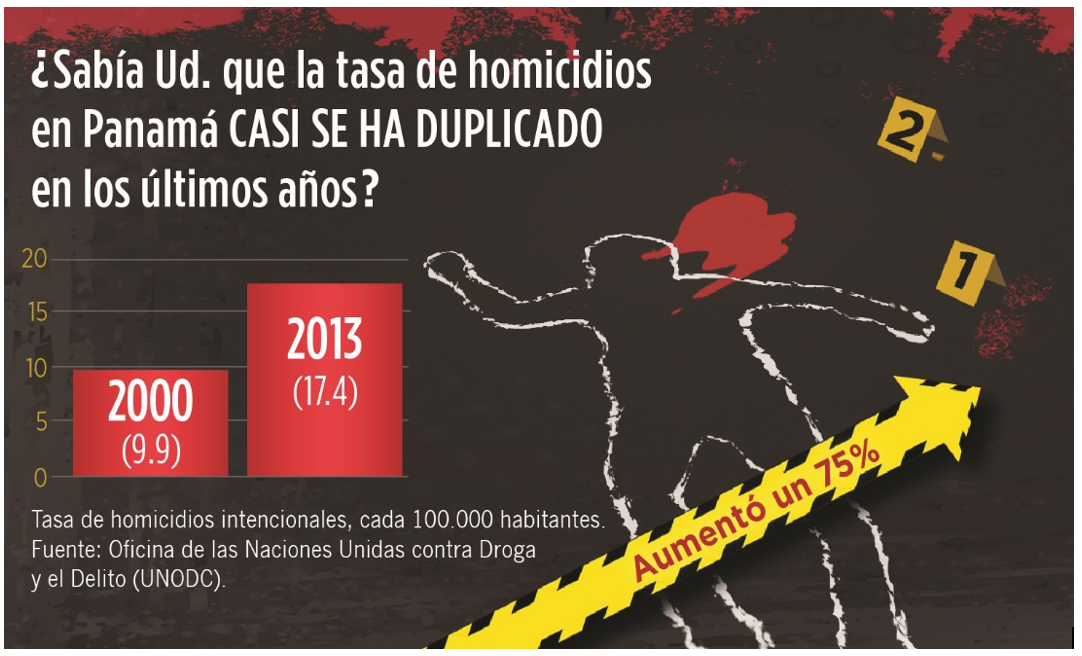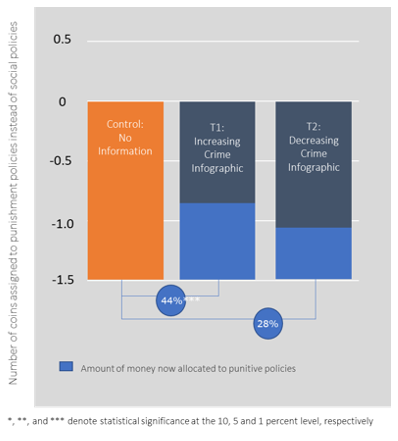Can There Ever Be Good News on Crime?

Context
Policies are often subject to “intertemporal stickiness”—they change too slowly to promptly address the public’s changing needs. Anti-crime policies in Latin America are no exception to this tendency and are particularly interesting due to the high stakes and high public finance costs associated with them.
Specifically, mass incarceration gained support as a response to public concern over drug use and at a time when violent crime was at a historical peak. Crime rates have subsequently declined; meanwhile, evidence suggests that mass incarceration has negative spillover effects on society. Anti-crime policies have nonetheless remained unchanged, which suggests that an information-processing problem may be involved.
The Project
This experiment tries to shed light on how positive or negative news on crime affects demand for anti-crime policies. Different framings of information on crime were presented to participants of the 2017 Latin America Public Opinion Project (LAPOP) survey in Panama.
Behavioral Analysis
Behavioral Barriers
Attribute substitution: This is a cognitive bias by which a simple (“knee-jerk”) emotional response to a stimulus substitutes a more thoughtful consideration of the same stimulus. In this context the framing of negative crimes affects information processing.
Availability heuristics: Individuals tend to estimate the probability of a future event based on how readily representative examples of such an event come to mind. For example, estimating the probability of a crime, or of being a crime victim, based on recent events that come to mind quickly.
Behavioral Tools
Framing: The way in which information is presented influences people’s conclusions. For example, options may be presented in a way that highlights their positive or negative aspects, leading each to be perceived as relatively more or less attractive.
Intervention Design
An information experiment was designed and embedded in the 2016/2017 round of the Americas Barometer Survey conducted by LAPOP in Panama. The experiment consisted of presenting infographics consistent with the existence of high- or low-crime policy regimes to randomly assigned subjects from a total pool of 1,521 respondents. Both messages were factually accurate and based on crime statistics for the country. No information was shown to the control group. The survey provides a nationally representative stratified sample of Panamanians, and interviews were conducted in a face-to-face format using electronic tablets.
Each respondent in the survey was randomly assigned to one of three different experimental conditions. The first two conditions presented respondents with graphical displays (see figure 1) describing the homicide rate in Panama in recent years. In the third condition, the control, no information was provided.
Figure 1. Information Treatments
Treatment 1: Increase in homicides

Treatment 2: Decrease in homicides

Challenges
- Adding policy questions to opinion surveys can provide a better understanding of how policy is formulated. Traditionally, divergences between the policies implemented by countries and those recommended by technocrats have been explained by the incentives of politicians. However, policy choices in competitive political environments also reflect citizens’ demands, which may differ greatly from those anticipated by the accountability framework. A better understanding of how citizens acquire, maintain, or shift their preferences in specific areas of public policy is an essential component of any assessment of the performance of a country’s democratic system.
- Adding policy instruments to the traditional analytical model of crime allows one to better explain actual anti-crime policy choices across democracies. In the future, researchers may want to further extend these models in order to capture the greater complexity that policy makers and citizens face when constructing policy on this issue.
Challenges
- Adding policy questions to opinion surveys can provide a better understanding of how policy is formulated. Traditionally, divergences between the policies implemented by countries and those recommended by technocrats have been explained by the incentives of politicians. However, policy choices in competitive political environments also reflect citizens’ demands, which may differ greatly from those anticipated by the accountability framework. A better understanding of how citizens acquire, maintain, or shift their preferences in specific areas of public policy is an essential component of any assessment of the performance of a country’s democratic system.
- Adding policy instruments to the traditional analytical model of crime allows one to better explain actual anti-crime policy choices across democracies. In the future, researchers may want to further extend these models in order to capture the greater complexity that policy makers and citizens face when constructing policy on this issue.
Figure 2. Impact of Crime Information on Policy Preferences

- The findings suggest that all news about crime, regardless of the direction, tends to elicit punishment-oriented responses from the electorate.
- The effects of information vary depending on individuals’ previous level of news consumption. Those with low access to information reacted much more strongly to the new information presented than those who were better informed.
Policy Implications
- Political communication about crime, in and of itself, tends to lead citizens to favor punitive policies, and reversing policies in favor of more effective strategies to combat crime is likely to be quite difficult.
- These results highlight the relevance of information, particularly one-sided “if it bleeds it leads” journalism, since it can easily drive policy preferences. Also, they underscore the importance of institutions that promote political competition and reduce the incentives of news organizations and social media to exploit individuals’ biases and cognitive limitations.
- The results are consistent with observational and experimental research that has shown that threat-inducing stimuli on topics such as terrorism can generate knee-jerk responses in favor of punitive policies.
